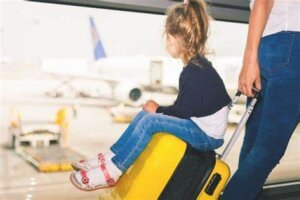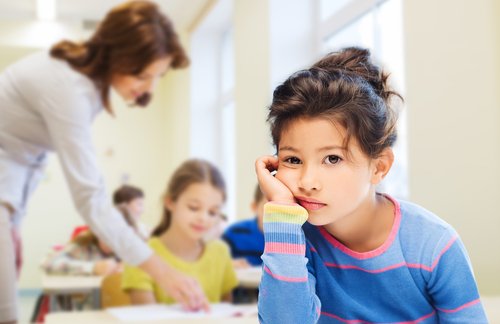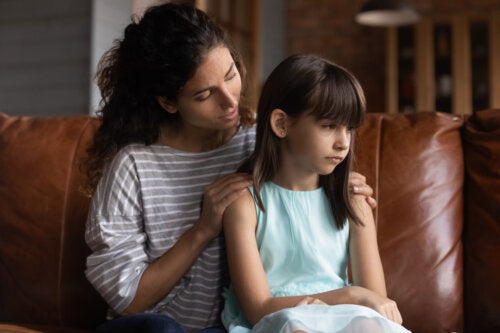How Does Migratory Grief Manifest Itself in Children?


Written and verified by the psychologist Sharon Capeluto
Talking about migratory grief in children is more than pertinent. For various reasons, more and more children are leaving their homes. As they leave behind everything they know and face uncertainty, their world is shaken by an avalanche of changes and emotional challenges that are worth attending to.
This grief can manifest itself in very different ways in each child. However, we know that sadness, anxiety, fears, and behavioral changes are to be expected in this situation. In the following article, we’ll go deeper into the subject and provide recommendations to accompany the process of uprooting and adaptation.
What is migratory grief in children?
There are several reasons why a family may make the decision to leave. Among the main ones, we find the search for a better job and/or economic opportunities, war conflicts, and social persecution.
Although there are more traumatic reasons than others, and migration can occur in very heterogeneous conditions, the act of moving to a new city or country always implies a mourning process.
It’s an event that causes considerable changes in the child’s life and involves a great psychological effort.
The term childhood migratory grief is used to describe the process of adaptation and the usual emotional responses that children experience when leaving their place of origin.
According to Joseba Achotegui, a renowned psychiatrist specializing in migration at the University of Barcelona, migratory grief is multiple, as it involves a series of significant losses.
Whether permanent or temporary, people move away from their homes, their traditions, and their cultures. Also, from friendships or family ties and even, in some cases, from their native language. In this regard, it’s impossible to think that this generalized disconnection goes unnoticed and doesn’t produce psychological effects.
How does it manifest itself?
The manifestations of childhood migratory grief depend on many factors, such as the family’s socioeconomic situation, access to support and services, individual circumstances, or the new relationships that children establish or don’t establish at school. However, there are certain externalizations that appear very often, such as the ones we’ll discuss below.
Ambivalent feelings

It’s common for mixed or contradictory emotions to arise, as discovering a new home and way of life can both stimulate children and generate fear and worry. They often don’t understand why they must say goodbye to their friendships and homes, which makes the separation process difficult.
On the other hand, when children are older and understand what they’re experiencing more clearly, they may feel hope for a better life. However, the feelings of homesickness, loneliness, and sadness about leaving their home are intense.
Read also: What Should You Consider Before Moving Abroad with Children?
Aggressiveness or isolation
As indicated by a study carried out at the Antonio Ruiz de Montoya University in Peru, the frustration that some children feel when faced with moving can lead them to adopt harmful social behaviors, such as physical or verbal aggression or voluntary isolation.
In the case of refugee children, the situation of vulnerability is notorious. It’s common for them to feel excluded or different due to cultural or linguistic barriers. This may lead them to avoid social contact or assume defiant behaviors as a way of expressing their pain, anger, or frustration.
Somatic complaints
Pre-adolescents and adolescents may express their discomfort explicitly through language, while younger children do so through the body. Among the most frequent physical symptoms are the following:
- Headaches
- Fatigue
- Tiredness
- Abdominal pain or vomiting
- Loss or increase in appetite
- Sleep disturbances or nightmares
Anxiety
The uncertainty and changes associated with migration are aspects that feed the appearance of anxiety. It’s common for children to be concerned about adapting to a new environment, making new friends, and adjusting to the customs of the new country or city. At the same time, they may feel fear of the unknown, such as the new language or situations they must face.
Developmental arrest or regression
When migration is confusing or traumatic, it’s usual for regression to appear in sphincter control or language (they start talking like babies again), in addition to bewilderment or spatial-temporal disorientation. This is explained by a study carried out by the Journal of Applied Developmental Psychology on refugee children in Lebanon.
Likewise, academic performance may be hindered, as priorities are reorganized according to the particularly destabilizing moment they’re going through.
How to accompany children’s grief

Accompanying children during the process is essential to helping them cope with the challenges and thus contribute to their well-being. In the first instance, and if possible, we should provide them with information about migration considering their level of understanding, as well as their social situation.
It’s best to involve them from minute zero to avoid the decision being perceived as a bitter and abrupt surprise. However, it’s not advisable to anticipate the move if it’s not yet confirmed.
At the same time, it’s essential to validate their emotions, however confusing or intense they may be. Judging or minimizing what they feel is something to avoid. Providing support also means offering open and honest communication.
It’s also essential to maintain some routines or structures in their daily life, even if the context has changed. For example, maintaining hygiene or sleep habits and shared moments of family games is very useful to counteract the possible feeling of loss of identity.
Childhood migratory grief may require professional help
As you can see, it’s not only adults who are affected by migration. Children are also forced to go through a process of loss in order to rebuild their lives. Unusual tantrums, feelings of stress, sadness, and anger, as well as certain adverse social behaviors, are to be expected.
Although not always necessary, children may require professional accompaniment. If the emotional or behavioral symptoms are prolonged over time or are disproportionate, it’s important to consider seeking psychological support to help them cope with the challenges of moving.
Talking about migratory grief in children is more than pertinent. For various reasons, more and more children are leaving their homes. As they leave behind everything they know and face uncertainty, their world is shaken by an avalanche of changes and emotional challenges that are worth attending to.
This grief can manifest itself in very different ways in each child. However, we know that sadness, anxiety, fears, and behavioral changes are to be expected in this situation. In the following article, we’ll go deeper into the subject and provide recommendations to accompany the process of uprooting and adaptation.
What is migratory grief in children?
There are several reasons why a family may make the decision to leave. Among the main ones, we find the search for a better job and/or economic opportunities, war conflicts, and social persecution.
Although there are more traumatic reasons than others, and migration can occur in very heterogeneous conditions, the act of moving to a new city or country always implies a mourning process.
It’s an event that causes considerable changes in the child’s life and involves a great psychological effort.
The term childhood migratory grief is used to describe the process of adaptation and the usual emotional responses that children experience when leaving their place of origin.
According to Joseba Achotegui, a renowned psychiatrist specializing in migration at the University of Barcelona, migratory grief is multiple, as it involves a series of significant losses.
Whether permanent or temporary, people move away from their homes, their traditions, and their cultures. Also, from friendships or family ties and even, in some cases, from their native language. In this regard, it’s impossible to think that this generalized disconnection goes unnoticed and doesn’t produce psychological effects.
How does it manifest itself?
The manifestations of childhood migratory grief depend on many factors, such as the family’s socioeconomic situation, access to support and services, individual circumstances, or the new relationships that children establish or don’t establish at school. However, there are certain externalizations that appear very often, such as the ones we’ll discuss below.
Ambivalent feelings

It’s common for mixed or contradictory emotions to arise, as discovering a new home and way of life can both stimulate children and generate fear and worry. They often don’t understand why they must say goodbye to their friendships and homes, which makes the separation process difficult.
On the other hand, when children are older and understand what they’re experiencing more clearly, they may feel hope for a better life. However, the feelings of homesickness, loneliness, and sadness about leaving their home are intense.
Read also: What Should You Consider Before Moving Abroad with Children?
Aggressiveness or isolation
As indicated by a study carried out at the Antonio Ruiz de Montoya University in Peru, the frustration that some children feel when faced with moving can lead them to adopt harmful social behaviors, such as physical or verbal aggression or voluntary isolation.
In the case of refugee children, the situation of vulnerability is notorious. It’s common for them to feel excluded or different due to cultural or linguistic barriers. This may lead them to avoid social contact or assume defiant behaviors as a way of expressing their pain, anger, or frustration.
Somatic complaints
Pre-adolescents and adolescents may express their discomfort explicitly through language, while younger children do so through the body. Among the most frequent physical symptoms are the following:
- Headaches
- Fatigue
- Tiredness
- Abdominal pain or vomiting
- Loss or increase in appetite
- Sleep disturbances or nightmares
Anxiety
The uncertainty and changes associated with migration are aspects that feed the appearance of anxiety. It’s common for children to be concerned about adapting to a new environment, making new friends, and adjusting to the customs of the new country or city. At the same time, they may feel fear of the unknown, such as the new language or situations they must face.
Developmental arrest or regression
When migration is confusing or traumatic, it’s usual for regression to appear in sphincter control or language (they start talking like babies again), in addition to bewilderment or spatial-temporal disorientation. This is explained by a study carried out by the Journal of Applied Developmental Psychology on refugee children in Lebanon.
Likewise, academic performance may be hindered, as priorities are reorganized according to the particularly destabilizing moment they’re going through.
How to accompany children’s grief

Accompanying children during the process is essential to helping them cope with the challenges and thus contribute to their well-being. In the first instance, and if possible, we should provide them with information about migration considering their level of understanding, as well as their social situation.
It’s best to involve them from minute zero to avoid the decision being perceived as a bitter and abrupt surprise. However, it’s not advisable to anticipate the move if it’s not yet confirmed.
At the same time, it’s essential to validate their emotions, however confusing or intense they may be. Judging or minimizing what they feel is something to avoid. Providing support also means offering open and honest communication.
It’s also essential to maintain some routines or structures in their daily life, even if the context has changed. For example, maintaining hygiene or sleep habits and shared moments of family games is very useful to counteract the possible feeling of loss of identity.
Childhood migratory grief may require professional help
As you can see, it’s not only adults who are affected by migration. Children are also forced to go through a process of loss in order to rebuild their lives. Unusual tantrums, feelings of stress, sadness, and anger, as well as certain adverse social behaviors, are to be expected.
Although not always necessary, children may require professional accompaniment. If the emotional or behavioral symptoms are prolonged over time or are disproportionate, it’s important to consider seeking psychological support to help them cope with the challenges of moving.
All cited sources were thoroughly reviewed by our team to ensure their quality, reliability, currency, and validity. The bibliography of this article was considered reliable and of academic or scientific accuracy.
- Achotegui, J. (2009). Migración y salud mental. El síndrome del inmigrante con estrés crónico y múltiple (síndrome de Ulises). Zerbitzuan. 163-171. DOI:10.1016/S0304-4858(09)74665-7
- Farfán Cango, M. S. (2021). Experiencias del duelo migratorio en niños venezolanos de entre 6 a 12 años de una casa de acogida de Lima Metropolitana. Tesis de grado Licenciatura en Psicología. Universidad Antonio Ruiz de Montoya. https://repositorio.uarm.edu.pe/bitstream/handle/20.500.12833/2317/Farfan%20Cango%2c%20Maria%20Soledad_Tesis_Licenciatura_2021.pdf?sequence=1&isAllowed=y
- Inzunza Gillibrand, K. M., Videla Contreras, V., & Mirone Munoz, D. (2014). Manifestación del duelo migratorio en niños y niñas inmigrantes peruanos residentes en Santiago de Chile. Doctoral dissertation, Universidad Academia de Humanismo Cristiano. http://bibliotecadigital.academia.cl/xmlui/bitstream/handle/123456789/1383/tpsico%20545.pdf?sequence=1
- Kim, H. Y., Brown, L., Dolan, C. T., Sheridan, M., & Aber, J. L. (2020). Post-migration risks, developmental processes, and learning among Syrian refugee children in Lebanon. Journal of Applied Developmental Psychology, 69, 101142. https://www.sciencedirect.com/science/article/pii/S0193397319301807
- Narea, M., Caqueo-Urízar, A., Torres-Irribarra, D. et al. (2022). Evaluación de la Salud Mental de la Primera Infancia en Niños Inmigrantes y Locales en Chile. Child Ind Res 16, 337–356. https://doi.org/10.1007/s12187-022-09972-y
- Vera Fernández, R. (2019). Una revisión teórica sobre el duelo migratorio. Universidad de La Laguna. http://riull.ull.es/xmlui/handle/915/16879
This text is provided for informational purposes only and does not replace consultation with a professional. If in doubt, consult your specialist.








